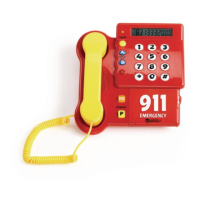You get a scary telephone call
Your smoke detector sounds an alarm
A stranger makes you feel scared
It's usually not good to call 911 when these things happen:
You hear a loud party
The bathtub is overflowing
You miss the school bus
You get mad at your friend
A car alarm goes off
Your pet runs away
A stranger walks through your neighborhood
3.Explain to your child what will happen when he or she calls 911.
Usually the 911 operator will ask a caller to state his or her name,
telephone number, and location. They will also ask the caller to
describe the emergency. Tell your child to give the operator the
information they ask for, follow the operator's instructions, and do not
hang up.
Telephone Manners
Use the Teaching Telephone to teach your child good telephone manners
and skills. Use the following activities and explanations to help them
learn, and practice good telephone manners yourself to set a good
example.
• Answering the Telephone: Discuss with your child the way you would
like he or she to answer the telephone. Usually, a clear "Hello" is your
best bet. You may also instruct your child to say: "May I ask who is
calling, please" when the caller asks to speak with someone at your
home. This helps identify the caller to your child, and allows your child
to tell family members who is calling. You may wish to tell your child
not to disclose his or her name, age, or grade to strange callers, and be
sure he or she never tells a telephone caller that he or she is home
alone.
• For Older Children – Answering the Telephone While Home Alone:
If your child will be home alone, decide whether or not you would like
him or her to answer the telephone. If he or she will be answering the
telephone, provide him or her with a response to use if a caller asks for
someone who is not home. Some possible responses include: "He or she
6
cannot come to the phone right now. May I take a message?" Or "He or
she is busy right now. May I take a message?" Practice these responses
using the Teaching Telephone, and then ask a friend or family member
to call your home pretending they are a stranger so your child can
practice answering the telephone.
• Taking a Message: If you would like your child to take telephone
messages, provide him or her with a clear reminder of the information
he or she needs to ask from the caller. You may wish to post a sign on
the wall to remind your child to write down:
1. The caller's name
2. The caller's telephone number
3. The caller's message or request
Keep a pad of paper and pens or pencils near every telephone in the
house to make message-taking easy. Your child can practice taking
messages using the message pad on the Teaching Telephone.
Just For Fun!
My Own Telephone book
Help children make their own telephone book. List names and telephone
numbers of friends and relatives. Include a picture of each person next to
his or her name. Children can use their telephone book to look up
numbers and practice dialing them on the Teaching Telephone!
Operator
Have children take turns pretending they are the “operator.” Write a
number on the note pad and ask the operator to put the call through for
you! Children can press * for ringing or # for busy. Unplug one of your
real telephones and pretend to talk to the operator on the phone! Now it is
your turn to be operator and children can choose the telephone numbers.
7
Quick Reminder
(Turn Power on and take receiver off hook)
To Program: Hold P, press #, dial number, release P, press #
To Record: Hold rec and
P, wait for beep, record message
(see page 3 for detailed instructions)

